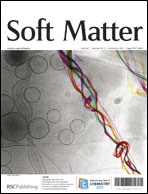Inverse patchy colloids: from microscopic description to mesoscopic coarse-graining
Abstract
Typically, patchy systems are characterized by the formation of a small number of directional, possibly selective, bonds due to the presence of attractive regions on the surface of otherwise repulsive particles. Here, we consider a new type of particles with patterned surfaces and we refer to them as inverse patchy colloids because, in this case, the patches on the repulsive particles repel each other instead of attracting. Further, these patches attract the parts of the colloid that are free of patches. Specifically, we consider heterogeneously charged colloids consisting of negatively charged spherical particles carrying a small number of positively charged patches. Making use of the Debye–Hückel theory, we derive the effective interaction potential between a pair of inverse patchy colloids with two patches on opposite poles. We then design a simple coarse-grained model via a mapping with the analytical pair potential. The coarse-grained model quantitatively reproduces the features of its microscopic counterpart, while at the same time being characterized by a much higher degree of computational simplicity. Moreover, the mesoscopic model is generalizable to an arbitrary number of patches.


 Please wait while we load your content...
Please wait while we load your content...